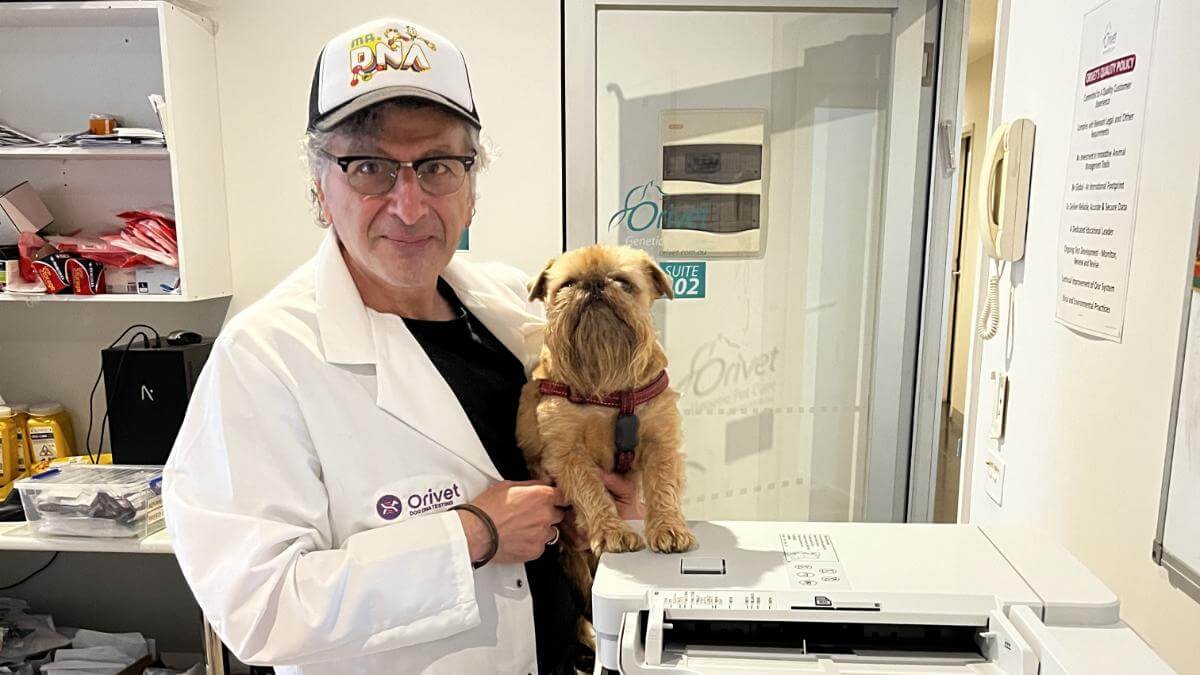
Home » Genetic George’s: Monthly Musings – Riddle Me This…

Question: What comes in every shade, changes with science, and can cause breeders and judges to argue in circles?
Answer: Dog coat color genetics.
It’s one of the most visually celebrated yet scientifically misunderstood topics in dog breeding. And like any good geneticist—or anyone who’s owned a Dapple Dachshund—knows, the story always goes deeper than the surface.
Color is one of the first traits we notice in a dog. It inspires passion, influences placement, and sometimes stirs controversy. In the modern era, it also drives testing.
Genetic color testing has become the flashlight in a fog of changing standards, rare variants, and unexpected results. Among the most debated: Merle, or in the Dachshund world, “dapple.”
Merle (dapple) is the result of a SINE insertion in the PMEL gene, producing that iconic marbled coat. It’s dominant—one copy shows the pattern; two copies raise red flags. Double dapple/merle dogs, especially in Dachshunds, are at risk of congenital deafness and ocular abnormalities. That’s why Orivet’s Merle Base Pair Test matters; it detects cryptic dapples/merles, those visually solid dogs silently carrying the mutation.
Understanding this can prevent unintentional high-risk matings.
The Sporting Group doesn’t always steal the limelight in genetic conversation, but it should.
From Labrador Retrievers to spaniels, these dogs work, play, and love hard. They’re built to retrieve, swim, flush, and point, but many carry recessive conditions best caught before they’re passed on.
Progressive Rod Cone Degeneration (prcd-PRA) is a prime example; it is a retinal disease that leads to late-onset blindness. Labrador Retrievers, Golden Retrievers, and Cocker Spaniels may carry it. Early screening can inform mating decisions before vision loss occurs.
Then there’s coat pattern:
Enter Orivet’s new breeder tool: Build Your Own Panel.
No more paying for tests you don’t need. Whether you’re breeding Pharaoh Hounds and monitoring for autoimmune risks or managing heart conditions in Irish Wolfhounds, now you can choose only the tests that matter to you and your breeding program.
Customize for your breed, goals, and geographic focus. It’s smarter testing, for smarter breeding.
Let’s revisit our old friend the Dachshund—a breed known for its long spine, bold personality, and unfortunately, disc disease.
Intervertebral Disc Disease (IVDD) and its genetic cousin Chondrodystrophy (CDDY) are linked to an FGF4 retrogene insertion on CFA12. This mutation causes premature disc degeneration and can lead to sudden paralysis.
And while IVDD is classic in Dachshunds, the CDDY mutation is now being found in Beagles, French Bulldogs, and other short-legged breeds. Testing doesn’t mean disqualification; it means informed, responsible decisions to avoid doubling up carriers and risking severe mobility issues in pups.
The Whippet: lean, fast, elegant. But genetically? One to watch for MDR1 mutations, which impact drug sensitivity, especially to ivermectin and some chemotherapy drugs.
Pharaoh Hounds, meanwhile, are underrepresented in genetic databases. As their popularity grows, breeders should consider screening for:
Charlie, the always-curious gentleman, flicks his ears:
“People ask why their dog looks one way but tests another… I say, your eyes see the coat, but your DNA sees the truth.”
Mary, nestled into a sunbeam with her certificates:
“I may be a Griffon by name, but my DNA says I’ve got Bulldog in my bounce and Saint Bernard in my patience.”
They say it best.
A groundbreaking new study published in Allergy has found that human babies exposed to pet dogs during their first year were significantly less likely to develop eczema—but only if they carried a high-risk gene variant.
Researchers showed that dog allergens reduced inflammation in the skin cells of children with this genetic risk, a breakthrough in understanding the gene-environment interaction.
Notably, cats did not offer the same protection.
This supports the “hygiene hypothesis”: that early exposure to microbes (like those on our furry friends) helps the immune system develop appropriate responses, potentially reducing inflammatory conditions later in life.
Breeder takeaway? Genetics matter, but so does environment. Sometimes the best prescription for healthy skin… is a puppy.
From dapple to double dapple/merle, from IVDD to MDR1, today’s breeders are tasked with balancing aesthetics, health, and ethics. Genetics is no longer a niche topic—it’s foundational.
At Orivet, we’re committed to making complex science digestible, actionable, and personalized. Our tools empower breeders to test smarter, not harder. Whether it’s coat color, disease predisposition, or drug sensitivity, the data is there—we just help you unlock it.
Visit www.orivet.com to learn more or begin building your own panel today.
“Smart Genetics, Smarter Pet Care™” – The Orivet Way.
